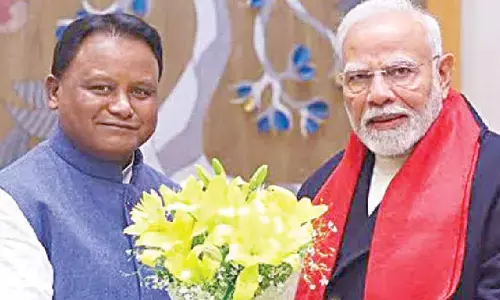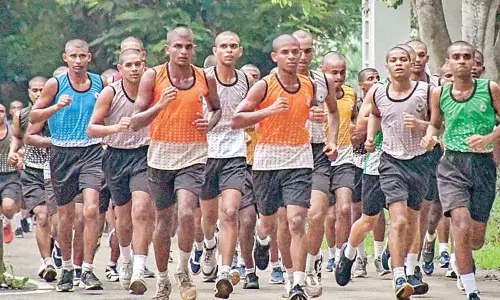It's now or never moment for agriculture

It's now or never moment for agriculture
At a time when the emphasis of all governments is heavily on Information Technology, Artificial Intelligence and other ‘vital’ areas, the year-long agitation of the North Indian farmers on the borders of the national capital has brought many key issues related to agriculture to the fore
At a time when the emphasis of all governments is heavily on Information Technology, Artificial Intelligence and other 'vital' areas, the year-long agitation of the North Indian formers on the borders of the national capital has brought many key issues related to agriculture to the fore.
The hitherto overlooked crucial aspects of farming are in for a nation-wide intense debate and discussion before and after the repeal of the three contentious farm laws. Though every political party is trying to derive some political mileage out of the situation, hapless farming community is anticipating a better deal, at least now. In all probability, the iron resolve of the agitating farmers may find a permanent solution to the vexatious long-pending issues. It's now or never moment for Indian agriculture, I feel.
Farming has turned out to be a gambling in our country. With the annual farm income subject to a good number of uncertainties, both nature-made and man-made, farming has been a financially risky venture. Thanks to the physical, psychological and economic stress involved in farming, no farmer wants to keep his wards in the perilous profession. In a way, agriculture economists welcome this trend.
The problem of our agriculture, these economists say, is that there are too many people employed in the sector. Whereas the agri sector contributes less than 25 per cent of the GDP, it employs 57 per cent of the workforce. The solution, according to them, is to improve the productivity of agriculture and reduce the numbers employed. "For the agriculture sector to become as productive as other sectors of the economy, it should employ only 17 to 20 per cent of the workforce — the overall size of which is estimated to be around 500 million. Therefore, approximately 200 million workers must migrate from agriculture to other sectors," an economist maintained. It doesn't mean that our focus should be on driving away people from agriculture. Instead, make every effort to support farmers, especially small farmers with less than two hectares of land.
India's agriculture sector hasn't been generating enough revenues to keep farmers profitable for nearly two decades, according to a study by the Organisation of Economic Cooperation and Development (OECD), a grouping of 36 countries, published way back in 2018. The study indicated that India presented a contrast with most other countries studied by OECD because of the prevalence of negative market price support and its size. In the 2000 to 2016 period, producer prices (prices farmers receive) have remained below those in international markets "for many years and for many commodities," it observed. Lack of a robust vision, political will and misplaced priorities put agriculture in jeopardy.
Thankfully, however, for the first time in the last 17 years, the share of agriculture in gross domestic product (GDP) has reached almost 20 per cent, making it the sole bright spot in GDP performance during 2020-21, as per the Economic Survey 2020-2021. The performance of our farmers even in the face of adversities made agriculture the only sector to have shown a positive growth of 3.4 per cent at constant prices in 2020-21, when other sectors fumbled. The share of agriculture in GDP increased to 19.9 per cent in 2020-21 from 17.8 per cent in 2019-20. The last time the contribution of the agriculture sector in GDP was at 20 per cent was in 2003-04. There is a light at the end of the tunnel and it is time to take this growth forward.
Governments' efforts to transform agriculture from a rural livelihood sector into a modern business enterprise failed to stop the suicide of farmers in the country. As a rural journalist, I extensively covered the agrarian crisis and found out the pathos created by the failed borewells, spurious seeds, fleecing moneylenders, nature's fury, scarcity of manpower, lack of support price, absence of market facilities and so on. Every farmer's suicide reflects the breakdown of the system and the failure of officials, leaders and elected representatives.
Unable to cope with financial distress and social humiliation, as many as 10,000 farmers are taking their lives every year in the country. As per the National Crime Records Bureau (NCRB), as many as 10,677 farmers or farm labourers preferred to end their lives rather than deal with the situation in 2020. It was 10,281 in 2019. Maharashtra recorded the highest number of suicides and Odisha, Talangana, Andhra Pradesh, Madhya Pradesh, Gujarat and Chhattisgarh are the other States where hapless formers resort to suicides at regular intervals.
Forming in India has been unprofitable for a long as successive governments have been playing the ostrich. The two-fold story of our farmers is, either bumper harvests and low prices, or dull harvest and heavy debts. Monsoons play truant for some years while heavy rains during the harvest time serve death blow to the farmers.
Realising the need of saving flood water, the YS Rajasekhara Reddy government launched ambitions multi-crore irrigation projects under 'Jala Yagnam,' which were followed up with four new projects – Kaleshwaram, Palamuru Rangareddy, Sitarama Lift Irrigation Scheme and Tupakula Gudem – during the Telangana Rashtra Samithi regime. The Chief Minister K Chandrashekar Rao boasts that the Kaleshwaram Lift Irrigation System, considered to be one of the world's largest multi-purpose projects, is a panacea for the water woes of Telangana. It is designed to provide water for irrigation and drinking purposes to about 45 lakh acres in 20 of the 31 districts in Telangana, apart from Hyderabad and Secunderabad. The cost of the project is Rs 80,000 crore, but will likely touch around Rs 1 lakh crore by the time it is completely constructed. It is a different story that the opposition parties keep on alleging that key persons in the government received huge kickbacks from the contractors of these mega projects.
In a bid to ease the burden on the farming community, the Union government launched the Pradhan Mantri Kisan Samman Nidhi Yojana (PM-Kisan) and transferred Rs 2,021 crore to the bank accounts of more than 10 million beneficiaries on February 24, 2019. As per the Union Budget 2021-22, Rs 65,000 crore was earmarked for the PM-Kisan.
The KCR government designed Rythu Bandhu, technically an 'Agriculture Investment Support Scheme,' in 2018-19 keeping in mind stagnation, low productivity, frequent occurrence of droughts, and low levels of public and private investments. In order to ensure that the farmers do not fall again into the debt-trap, the government is providing investment support for agriculture and horticulture crops by way of grant of Rs 5,000 per acre per farmer each season for purchase of inputs like seeds, fertilisers, pesticides, labour and other investments in the field operations of farmer's choice for the crop season. It is hailed as a unique scheme in the Indian agriculture history. Continuous research on such money transfer schemes is highly desirable to understand the impact and efficiency.
Politics over purchase
Even as the North Indian farmers were braving all odds to continue their agitation against the three farm laws, Telangana witnessed a different kind of fight launched by the State government against the Union government after the TRS party's humiliating defeat in the Huzurabad bypoll to the BJP in August 30, 2021. KCR kickstarted a serious discussion on the purchase of paddy soon after the electoral debacle and it snowballed into a major bone of contention between the State and the Centre.
KCR's press conference, held five days after his four-day camp at New Delhi on Monday made it abundantly clear to the farmers that the Centre is not going to buy 'yasangi' (rabi) crop. The TRS and the BJP leaders should stop the blame game for political one-upmanship. The State BJP leaders should impress upon the Centre to come to the rescue of farmers, who are left in lurch. At the same time, the TRS government should stop the bellicose attitude and explore an amicable solution to the issue.
Had KCR announced measures, such as seed subsidy for yasangi, it would have been done a world of good to the farmers. Crop insurance is another important requirement to keep up the morale of the farming community.
The Union government that took a few minutes to withdraw the three laws, as announced by the Prime Minister on November 19, 2021, shouldn't shy away from discussing the issues related to agriculture. The fears of a section of economists that the U-turn of the government will put the 126 million small and medium farmers at the mercy of market sharks following the repeal of the three laws should be addressed with a holistic approach. The Minimum Support Price (MSP), an eye-wash for farmers till now, should be legalised for at least two marketing seasons on an experimental basis. To pave a way for a threadbare discussion on each and every aspect of agriculture, a dedicated Parliament session is overdue. The onus of bringing out a comprehensive blueprint to find solutions once for all lies on each and every political party in this country. Remember, it's now or never.
(The author, a PhD in Communication and Journalism, is a senior journalist, journalism educator and communication consultant)
(The opinions expressed in this column are that of the writer. The facts and opinions expressed here do not reflect the views of The Hans India)














